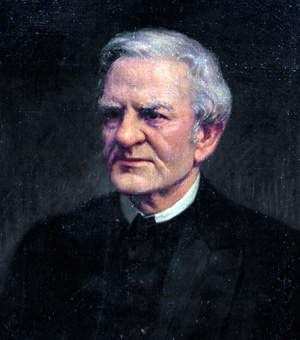William Henry Campbell
Rutgers President, 1862 to 1882

Returning to the field of education, he became principal of the Albany Academy in 1848, and in 1851, he assumed the position of professor of oriental languages in the theological seminary in New Brunswick. While in this position, he filled, gratuitously, the professor of belles lettres in Rutgers College during a period of 12 years. In 1862, Campbell was appointed president of Rutgers College.
Rutgers College transformed considerably during Campbell’s presidency. The changes were reflected in the students, the curriculum, the faculty, and the institutional structure of the college. In 1864 Rutgers gained further independence from the Reformed Dutch Church when the general church synod reconveyed Old Queens and campus to the college and withdrew its faculty from its teaching responsibility. The Rutgers Scientific School, established in 1862 with the assistance of professor George H. Cook, was designated by the legislature as the land-grant college for New Jersey in 1864 under the Morrill Act. The land-grant status brought Rutgers into a relationship with the State of New Jersey for the first time in its history.
President Campbell and the trustees completed the “New Endowment Fund” by raising over $137,000. They also assembled a strong and assertive faculty, individuals who differed significantly from their predecessors in background, scholarly achievement, and approach to knowledge. In 1872 construction was completed on Geological Hall, erected between Old Queens and Van Nest Hall, which housed an armory in the basement, laboratories for the physical sciences on the first floor, and a large museum on the second floor. In the same year the college received the residuary estate of Sophia Astley Kirkpatrick, in the amount of $65,000, which was used to construct the chapel that bears her name. The structure, which also contained a library, was dedicated in December 1873.
Rutgers was transformed during the presidency of William Henry Campbell. The college gained further independence from the Reformed Dutch Church and entered into a relationship with the State of New Jersey for the first time in its history. The first issue of the Targum was published, the song “On the Banks” was composed, and the first intercollegiate football contest was played between Rutgers and Princeton.
In spite of the expanded facilities, increased endowment, new curriculum, and learned faculty, Rutgers College never had sizable enrollments of students during William Campbell’s administration. There were rarely more than 170 students attending the college at one time, and in 1882, the last year of his presidency, there were only 113. Nonetheless, the students of the college proved to be successful in their studies and in the careers they entered following graduation. During their collegiate years, they established several significant organizations, activities, and enterprises that were to become traditional to Rutgers. In January 1869, the first issue of the student newspaper, the Targum was published, and two years later the first college annual, the Scarlet Letter, was issued by the junior class. In 1873 the Rutgers Glee Club was formed and with it, the song “On the Banks” was composed by Howard N. Fuller. The first athletic clubs were formed during the 1860s and 1870s, and in 1869, the first intercollegiate football contest was played between Rutgers and Princeton.
Following two very eventful decades, William H. Campbell resigned from the presidency of Rutgers College. Failing eyesight caused him to relinquish his duties, but he remained until a successor was found. In 1882 he left Rutgers to organize the Suydam Street Reformed Church, serving as its pastor until shortly before his death on December 7, 1890.
This biographical sketch was authored by Thomas J. Frusciano, Rutgers University Archivist. It originally appeared in The Journal of the Rutgers University Libraries.

